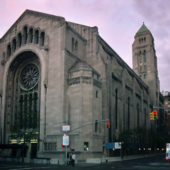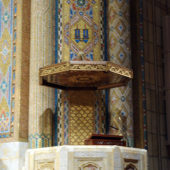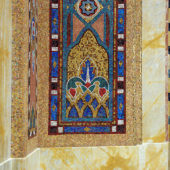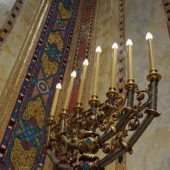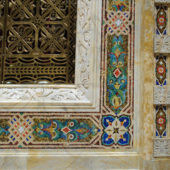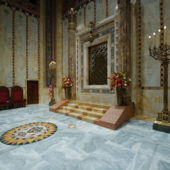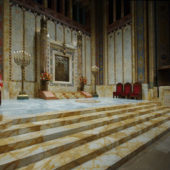Monumental in size yet graceful and magnificently decorated.
Monumental Temple Emanu-El, the first Reform Synagogue of New York City, is the largest synagogue in the world. Its story began in 1845, when thirty-three German Jews rented a room on Grand and Clinton Streets, thus forming the first Synagogue in New York City. They called themselves Emanu-El, translated, “God is with us.” The congregation continued to meet there until 1845, at which time it rented larger premises, due to its growing congregation. By 1847 the congregation was large enough and had amassed sufficient funds to purchase the Methodist church at 56 Chrystie Street. Architect Leopold Eidlitz was hired to refurbish the beautiful building for Emanu-El.
In the beginning of 1854 the congregation purchased a prior Baptist Church, Gothic Revival in design, at 110 East 12th Street. Eman-uel continued to worship there until 1868, at which time it constructed a new Synagogue for the first time, at Fifthth Avenue and 43rd Street. That Synagogue was praised for its exemplary Moorish design. The building was testimony to the financial achievements of German Jews in New York City, and to the fact that America was in fact, the ‘Land of Opportunity.’ Emanu-El was touted as being the most elegant Jewish house of worship in America.
In 1916 Civil rights activist and lawyer Louis Marshall became president of Emanu-El, and a distinctive force with regard to influencing its future. He fought for the preservation of rights of Jews and other minorities. The merging of Emanu-el with Temple-Beth-El occurred under his leadership. By 1925 the congregation’s membership had tripled since 1895 and under President Marshall’s leadership, bought John Jacob Astor’s Mansion at Fifth Avenue and 65th Street for the site of the new Synagogue. The new building was occupied in 1929. President Marshall is quoted as saying, “Whatever action may be taken will mark a turning point not only in our history but in the life of the Jewish community of this great city and will have an important bearing upon the future of American Jewry. An Institution which does not grow becomes stagnant, and stagnation means spiritual death.”
In 1960 two religious schools were built. In 1982 Emanu-El launched its Sunday Lunch program for the hungry, which remains an important ministry to the present time. In 1997 the Greenwald Hall renovation project was completed, which included installation of stained glass windows, which previously graced the Emanu-el Salem Field cemetery chapel. The Herbert & Eileen Bernard Museum of Judaica opened in 1997. This is a place where people can learn about Jewish tradition and culture, in it’s many various forms, and from all around the world. A thorough restoration of the Emanu-El’s main sanctuary began in 2003.
Emanu-El is a magnificent example of Romanesque Revival design with Byzantine influences and has been hailed by many as one of the most beautiful houses of worship in the world. It can accommodate more worshippers than St. Patrick’s Cathedral, with seating for 2,500. Worldwide, among Jewish synagogues, only Budapest’s Doheny Street Synagogue seats six more worshippers, yet Emanu-El is larger in respect to square footage and interior volume.
Inside the main sanctuary, the décor reveals Moorish and Art Deco influences, warm tiles and stone, including. The bema is decorated with tile mosaics and hand-painted motifs on the ceiling and ceiling archways. Stunning stained glass windows feature biblical themes, and the numbers and shapes of the windows are not without meaning. The eighteen elongated oval windows are symbolic of the amidah, the eighteen-part daily prayer, and the numeral equivalent of the Hebrew word for life (chai). The seven arched narrow windows symbolize the seven days of creation, as well as the seven days of the week. This theme and design are repeated across the Sanctuary by the menorahs on either side of the Ark. We are again reminded of the 12 tribes of Israel as there are eight of the smaller and four of the taller lancet windows. This is echoed in the Temple’s massive bronze entrance doors. The Sanctuary is filled throughout with gorgeous items crafted from cast and wrought metals such as ornamental bronze, steel alloy, nickel and brass; the ark, menorahs and chandelier at the bema are such items and incorporate ceramic which has been inlaid with spectacular result, by the celebrated metalworker, Oscar Bach.
There is also an which organ rises three stories high and comprises thousands of pipes, ranging in length from the size from the size of a pencil to the entire three stories. The organ sits behind the Sanctuary’s magnificent metal-worked grilles. The organ has been restored and sits in a casing of beautiful woods and onyx.
In addition to the spectacular stained glass windows which adorn the walls, hand-painted motifs and scrollwork prolifically decorate the top and sides the ceiling to dramatic effect. The combination created between the proportions and volume of the sanctuary, height of the ceiling, beauty of the stone and tile, incredible metallurgy, inspiring stained glass windows and dramatic ceilings is one of awe-inspiring magnificence.
Today, Senior Rabbi Dr. David M. Posner leads a congregation of 3,000 families. The congregation offers daily services; Shabbat services; High Holiday services; religious education for men, women and children of every age; a museum with lectures on Jewish and cultural interest topics; a Sunday soup kitchen for the homeless; as well activities too numerous to list here.
Emanu-El is a Temple that is active and relevant in its congregants’ and neighbors lives and it seems that this will continue to be the case and that it will continue to grow in its ministry and outreach, as it has done these nearly 200 years.

